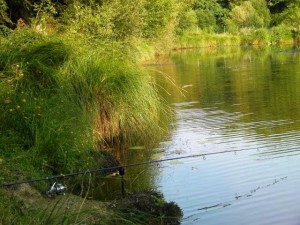
Owner, Dan Allen, with a 40lb+ from his venue, Oakwood
Fishing slack lines is nothing new, as an 11 year old boy I was using this tactic to catch small common carp alongside a reed bed at a local farm pond.
I quickly learnt that my arsley bomb set up with a relatively tight line (due to my Fairy washing up liquid top with added plasticine for an indicator) was alerting the carp to my presence as they brushed against the line while rooting about in the reed beds.
A change of approach was needed so off came the arsley bomb and on went two number 1 shot spaced two feet apart and 14 inches from my piece of luncheon meat. This was underarm cast as normal alongside the reeds but this time instead of attaching my washing up liquid top bobbin I was going to watch the line for movement, as I had pulled my lines slack to try and reduce the risk of the carp from bumping into them.
This resulted in much improved catch rates. This took place over 20 years ago, tactics like this have been employed by anglers who think about what goes on beneath the surface of the water for many years.
Now fishing slack lines is very much in “vogue”, everyman and his dog seem to be fishing this way judging by the anglers we have visit our fishery but there is a Time and a Place……….

A typical swim at Oakwood – slack lines would not be a good choice here
Most of my fishing at under 50 yards of the bank is done with a slack or semi-slack line, conditions permitting, usually also accompanied by a back lead. It’s the perfect way for fishing along a margin and concealing the line along the lake bed. Normally when a carp brushes against a slack line they ignore it, I think it feels like a piece of weed or bottom debris to them but watch what happens when they brush against a tight line, a very different story. It feels alien to them and generally causes the carp to spook alerting their natural instincts to some sort of danger present.
This said under no circumstances should you fish a slack line when you are fishing up against a snag. This is the point why I wanted to write this article. During the last year I have lost count of the number of times here at Oakwood that anglers have said to me “I don’t know what happened, I cast out over there, had a take and when I picked the rod up the fish was right through the pads over the other side of the swim”.
The trouble is lots of anglers copy what they see and hear about without giving it any thought. Fishing to a snag, be it lily pads or a fallen tree, you should be fishing with a tight line ideally locked up, if you are fast to your rods. This will normally cause the fish to kite away from the snag instead of going through it.
When I say tight line this doesn’t have to mean poor line concealment, a length of tungsten rig tube and a back lead will still keep the line pinned down but with instant bite detection and a controlled amount of line the carp can take so you can ensure it is very difficult for the carp to reach the danger area.

Slack lines are ideal in this margin fishing situation
Fishing to a snag at range I would also drop the back lead and use a flying back lead in its place. This set up will keep the rig concealed and pin a few meters of line down away from the rig but will give me instant detection as my line will be tight to the flying back lead.
This is opposed to using a normal back lead where there would be more line to take up during a run. This can be the difference between the fish reaching the safety of the snag or not.
Of course using a flying back lead there will be a tight line at some point in the swim but this is no price to pay for the safety of a carp. If I think there is a possibility I could cause harm to a carp by hooking it using a slack line I would rather not hook it in the first place.
We need to look after our quarry and maybe think more about the way we fish, be it slack lines to making sure all our rigs are as safe as they can be, to good carp care on the bank. Everyone likes the carp they catch to be in good condition without ripped mouths and damage, where the poor carp has had to free itself from a barbed hook because it has swam through a snag due to a slack line being incorrectly used.
As it says in the title… there’s a time and a place.

Comments